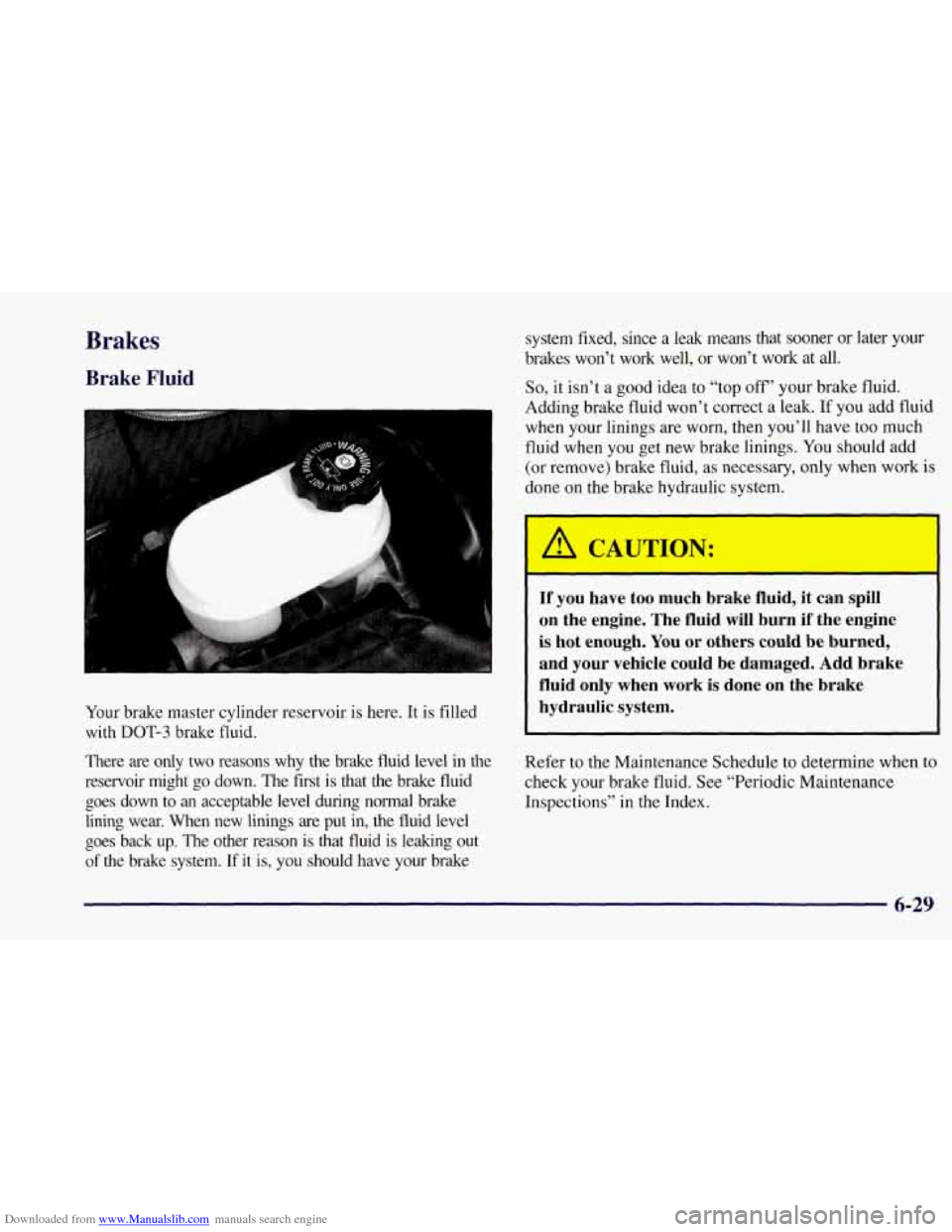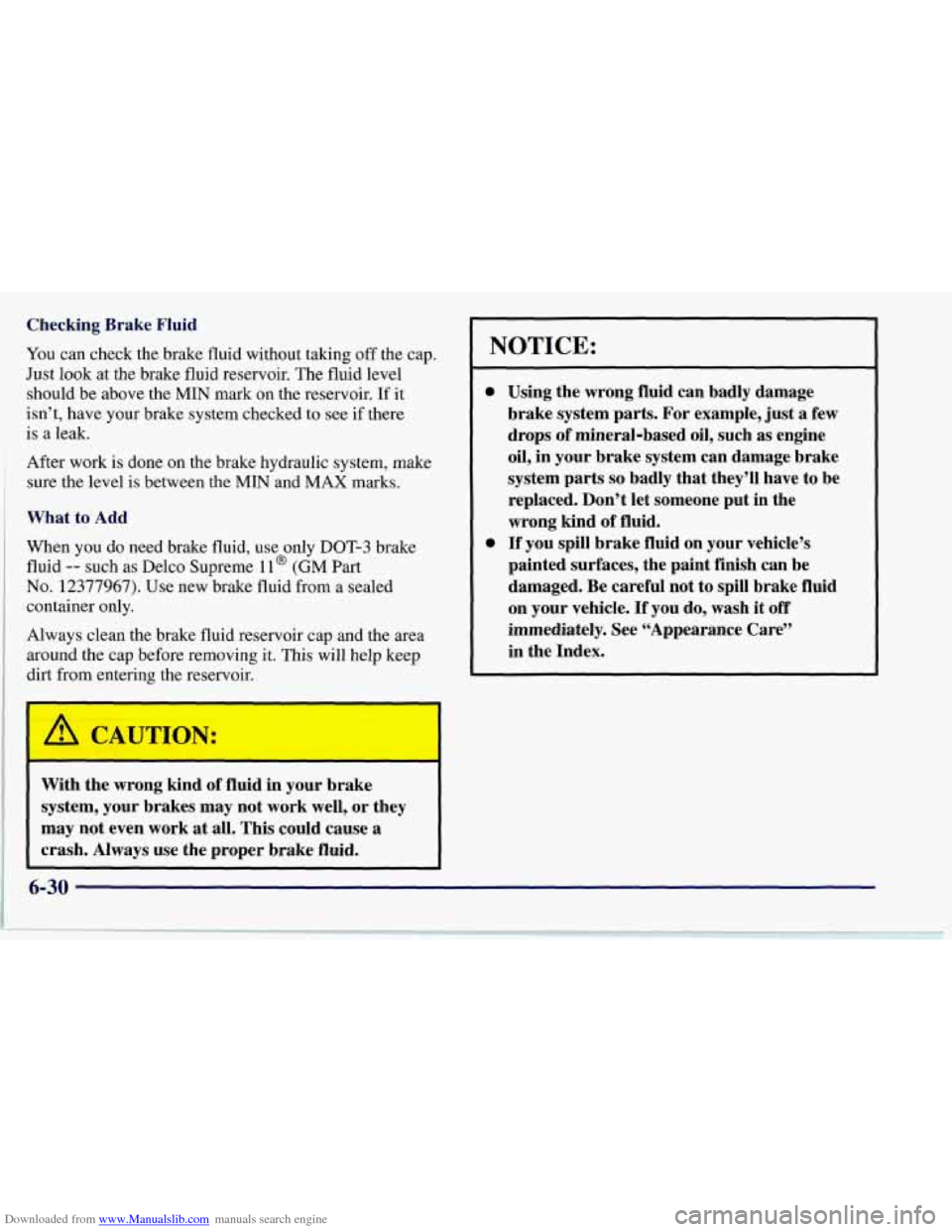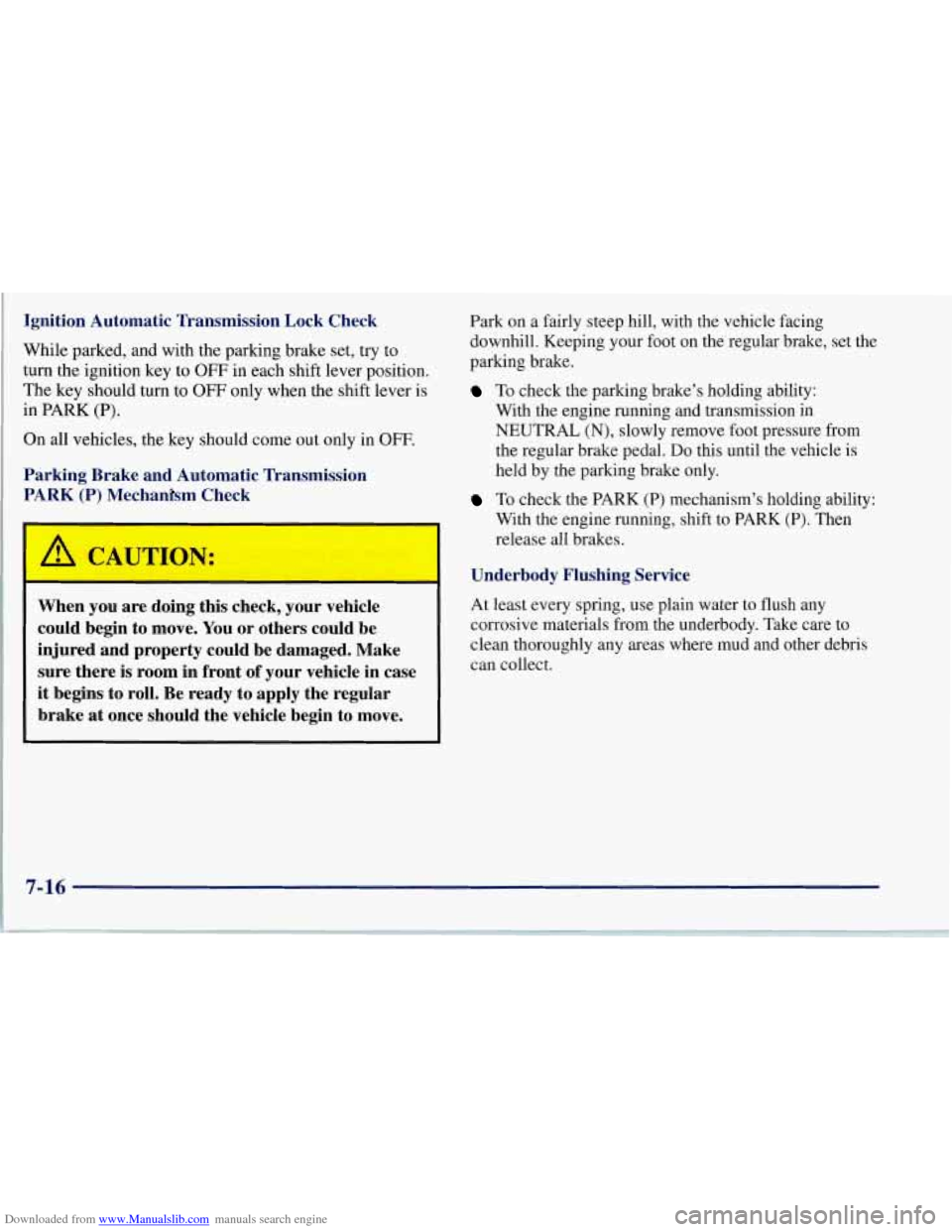Page 236 of 356

Downloaded from www.Manualslib.com manuals search engine e Section 6 Service and Appearance Care
Here you will find information about the care of your Corvette. This section begins with service and fuel information,
and then it shows how to check important fluid and lubricant levels. There is also technical information about your
vehicle, and a part devoted to its appearance care.
6-2 Service 6-3 Fuel
6-5 Fuels in Foreign Countries
6-5 Filling Your Tank
6- 8 Checking Things Under the Hood
6-1 1 Engine Oil
6-16 Air Cleaner
6-18 Automatic Transmission Fluid
6- 19 Manual Transmission Fluid
6-20 Hydraulic Clutch
6-22 Engine Coolant
6-26 Surge Tank Pressure Cap
6-26 Power Steering Fluid
6-22 Rear Axle
6-26
Thermostat
6-27 Windshield Washer Fluid
6-
29 Brakes
6-32 Battery 6-33
6-33
6-37
6-40
6-5
1
6-5 1
6-54
6-55
6-56
6-57
6-57 6-59
6- 60
6- 60
6-6 1
6-69
6-69 6-7
1
Bulb Replacement
Halogen Bulbs
Windshield Wiper Blade Replacement
Tires Appearance Care
Cleaning the Inside of Your Corvette
Care of Safety Belts
Cleaning the Outside of Your Corvette
Aluminum Wheels
Tires Underbody Maintenance
Appearance Care Materials
Vehicle Identification Number (VIN)
Service Parts Identification Label
Electrical System
Replacement Bulbs Capacities and Specifications
Air Conditioning Refrigerants
6-1
Page 264 of 356

Downloaded from www.Manualslib.com manuals search engine Brakes
Brake Fluid
6
Your brake master cylinder reservoir is here. It is filled
with
DOT-3 brake fluid.
There are only two reasons why the brake fluid level in the
reservoir might
go down. The first is that the brake fluid
goes down to
an acceptable level during normal brake
lining wear. When new linings are put in, the fluid level
goes back up. The other reason is that fluid is leaking out
of the brake system. If it is, you should have your brake system fixed, since a leak means that
sooner or later your
brakes won't work well, or won't work at all.
So, it isn't a good idea to "top off' your brake fluid.
Adding brake fluid won't correct a
leak. If you add fluid
when your linings are worn, then you'll have too much
fluid when
you get new brake linings. You should add
(or remove) brake fluid, as necessary, only when work is
done
on the brake hydraulic system.
A CAUTION:
If you have too much brake fluid, it can spill
on the engine. The fluid will burn if the engine
is hot enough. You
or others could be burned,
and
your vehicle could be damaged. Add brake
fluid only when work is done on the brake
hydraulic system.
Refer to the Maintenance Schedule to determine when to
check your brake fluid. See "Periodic Maintenance
Inspections" in the Index.
Page 265 of 356

Downloaded from www.Manualslib.com manuals search engine Checking Brake Fluid
You can check the brake fluid without taking off the cap. NOTICE:
Just look at the brake fluid reservoir. The fluid level
should be above the MIN mark on the reservoir.
If it
isn’t, have your brake system checked to see if there
is a leak.
After work is done on the brake hydraulic system, make
sure the level is between the MIN and MAX marks.
What to Add
When you do need brake fluid, use only DOT-3 brake
fluid
-- such as Delco Supreme ll@ (GM Part
No. 12377967). Use new brake fluid from a sealed
container only.
Always clean the brake fluid reservoir cap and the area
around the cap before removing it. This will help keep
dirt from entering the reservoir.
With the wrong kind of fluid in your b,,ke
system, your brakes may not work well, or they
may not even work at all. This could cause
a
crash. Always use the proper brake fluid.
0 Using the wrong fluid can badly damage
brake system parts. For example, just
a few
drops
of mineral-based oil, such as engine
oil, in your brake system can damage brake
system parts
so badly that they’ll have to be
replaced. Don’t let someone put in the
wrong kind of fluid.
0 If you spill brake fluid on your vehicle’s
painted surfaces, the paint finish can be
damaged. Be careful not to spill brake fluid
on your vehicle.
If you do, wash it off
immediately. See “Appearance Care”
in the Index.
6-30
Page 266 of 356

Downloaded from www.Manualslib.com manuals search engine Brake Wear
Your Corvette has four-wheel disc brakes.
Disc brake pads have built-in wear indicators that
make a high-pitched warning sound when the brake
pads are worn and new pads are needed. The sound may
come and go or be heard all the time your vehicle is
moving (except when you
are pushing on the brake
pedal firmly).
The brake wear warning sound means that soon
your brakes won’t work well. That could lead
to
an accident. When you hear the brake wear
warning sound, have your vehicle serviced.
NOTICE:
Continuing to drive with worn-out brake pads
could result in costly brake repair.
Some driving conditions or climates may cause a brake
squeal when the brakes are first applied or lightly
applied. This does not mean something is wrong with
your brakes.
Brake linings should always be replaced as complete
axle sets.
See “Brake System Inspection” in Section
7 of this
manual under Part
C “Periodic Maintenance
Inspections.”
Brake Pedal Travel
See your dealer if the brake pedal does not return to
normal height, or if there is a rapid increase in pedal
travel. This could be a sign of brake trouble.
Brake Adjustment
As you make brake stops, your disc brakes
automatically adjust for wear.
6-31
Page 267 of 356

Downloaded from www.Manualslib.com manuals search engine Replacing Brake System Parts
The braking system on a modern vehicle is complex. Its
many parts have to be of top quality and work well
together if the vehicle is to have really good braking.
Your vehicle was designed and tested with top-quality
GM brake parts. When you replace parts of your braking
system
-- for example, when your brake linings wear
down and you have to have new ones put
in -- be sure
you get new approved GM replacement parts. If you
don’t, your brakes may no longer work properly. For
example, if someone puts in brake linings that
are wrong
for your vehicle, the balance between your front and
rear brakes can change
-- for the worse. The braking
performance you’ve come to expect can change in many
other ways if someone puts in the wrong replacement
brake parts.
Battery
Every new Corvette has a Delco Freedom@ battery. You
never have to add water to one of these. When it’s time for
a new battery, we recommend a Delco Freedom battery.
Get one that has the replacement number shown on the
original battery’s label. For battery replacement, see your
dealer or the Corvette Service Manual. To purchase
a
service manual, see “Service and Owner Publications” in
the Index. After the battery has been replaced, refer to the “Remote Function Actuation System” in
the Index to
resynchronize your transmitter(s).
Vehicle Storage
If you’re not going to drive your vehicle for 25 days or
more, take
off the black, negative (-) cable from
the battery.
This will help keep your battery from
running down.
Batteries have acid that can burn you and gas
that can explode. You can be badly hurt
if you
aren’t careful. See “Jump Starting” in the Index
for tips
on working around a battery without
getting hurt.
Contact your dealer to learn how to prepare your vehicle
for longer storage periods.
Also, for your audio system, see “Theft-Deterrent
Feature” in the Index.
6-32
Page 301 of 356
Downloaded from www.Manualslib.com manuals search engine Engine Compartment Fuse Block
There is one fuse block in the engine compartment
located on the passenger’s side of the vehicle in front
of
the battery.
J
i EATT
J
Fuse
1
2
3
4
5
6
Usage
Rear Fog Lamp
Approach
Right Headlamp Motor
Left Headlamp Motor
Anti-Lock Brakes
Fog Lamp
‘ 6-66
Page 303 of 356
Downloaded from www.Manualslib.com manuals search engine Fuse
35
36
37
38 39
40
41
42
43
44
Usage
Micro Relay - Fuel Pump
Micro Relay
- Horn
Micro Relay - Rear Fog Lamp
Micro Relay
- Back-up Lamps
Micro Relay
- Fog Lamp
Micro Relay
- AIR Solenoid
Micro Relay
- Selective Real Time
Damping
Mini Relay
- Ignition
Mini Relay
- Cooling Fan 2
Mini Relay
- Cooling Fan 3
Fuse
45
46
47
48
49
50
51
52
53
54
Usage
Mini Relay - Cooling Fan 1
Maxi Fuse - Cooling Fan 2
Blank
Blank
Maxi Fuse
- Cooling Fan 1
Maxi Fuse - Air Pump
Blank
Maxi Fuse
- Anti-Lock Brakes
Anti-Lock Brakes and Selective Real
Time Damping Electronics
Fuse Puller
Page 323 of 356

Downloaded from www.Manualslib.com manuals search engine Ignition Automatic Transmission Lock Check
While parked, and with the parking brake set, try to
turn the ignition key
to OFF in each shift lever position.
The key should turn to
OFF only when the shift lever is
in PARK (P).
On all vehicles, the key should come out only in
OFF.
Parking Brake and Automatic Transmission
PP-K(P)” .mCt k
A CAUTION:
When you are doing this check, your vehicle
could begin to move. You or others could be
injured and property could be damaged. Make
sure there
is room in front of your vehicle in case
it begins to roll. Be ready to apply the regular
brake at once should the vehicle begin to move.
Park on a fairly steep hill, with the vehicle facing
downhill. Keeping your foot on the regular brake, set the
parking brake.
To check the parking brake’s holding ability:
With the engine running and transmission in
NEUTRAL
(N), slowly remove foot pressure from
the regular brake pedal.
Do this until the vehicle is
held by the parking brake only.
To check the PARK (P) mechanism’s holding ability:
With the engine running, shift to PARK (P). Then
release all brakes.
Underbody Flushing Service
At least every spring, use plain water to flush any
corrosive materials from the underbody. Take care to
clean thoroughly any areas where mud and other debris
can collect.